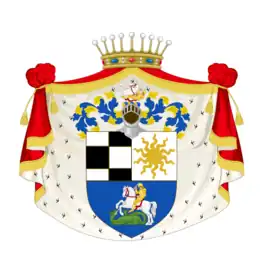| Count of Verampio | |
|---|---|
 | |
| Creation date | 1938 |
| Created by | Victor Emmanuel III of Italy |
| Peerage | Peerage of Italy |
| First holder | Ettore Conti of Verampio, Count of Verampio |
| Present holder | Castellini Baldissera |
| Seat(s) | Villa Castellini |
| Former seat(s) | Casa degli Atellani |
| Motto | "Agere Non Loqui" |
The Count of Verampio is a title in the Peerage of Italy. The current holders of the title are the Castellini Baldissera family.[1]
History
The title was created in 1938 for Ettore Conti, an Italian Industrialist and Philanthropist, who founded a number of his nation's energy corporations. Victor Emmanuel III of Italy created the title on the 9th of May 1938, by Royal Decree.[2] The County of Verampio was created in recognition of Conti's numerous contributions to Italy's energy and banking industry, and his role as a prominent public figure and Senator of The Realm.[3]
The title was part of a new series of peerages, which were created to reward the most important magnates of Fascist Italy. Similar titles were created for the likes of Giovanni Caproni (Count of Taliedo), Gabriele d'Annunzio (Prince of Montenevoso) and Pietro Badoglio (Marquis of Sabotino).[4] The creation of these titles is one of the principal reasons why Victor Emmanuel III is known by the moniker "The Fascist King," and has remained a deeply controversial figure in Italian public discourse.[5]
The County of Verampio was specifically chosen for Conti's title because the majority of his hydroelectric dams and property holdings were located in the locality's valley. The dams and administrative buildings are widely known for their elegant architectural design, which Conti pioneered with the help of Piero Portaluppi.[6]
Conti's design for his Coat of Arms incorporates the "Razza Viscontea" or Visconti Sun, as an homage to the ancient Milanese family. It also includes Saint George slaying the dragon, Conti's patron saint and checkers, as a reference to his appreciation for strategy.[7] The motto reads: "Agere Non Loqui" or "Act, Do Not Speak," which Conti's peers often jested was an allusion to his clandestine nature.[8]
References
- ↑ "LETTERE A - F". Accademia Araldica Nobiliare Italiana (in Italian). Retrieved 19 November 2023.
- ↑ "Scheda senatore CONTI DI VERAMPIO Ettore". notes9.senato.it. Retrieved 19 November 2023.
- ↑ "Ettore Conti Biografia". Treccani. 19 November 2023.
- ↑ Jocteau, Gian Carlo (2004). "I nobili del fascismo". Studi Storici. 45 (3): 677–726. ISSN 0039-3037. JSTOR 20567265.
- ↑ "The Fascist King: Victor Emmanuel III of Italy". National WWII Museum. Retrieved 19 November 2023.
- ↑ "Storia di Milano ::: Cronologia di Ettore Conti". www.storiadimilano.it. Retrieved 19 November 2023.
- ↑ "Storia di Milano ::: Cronologia di Ettore Conti". www.storiadimilano.it. Retrieved 19 November 2023.
- ↑ Zacevini, Gianni (17 October 2022). "Ettore Conti". Divina Milano (in Italian). Retrieved 19 November 2023.